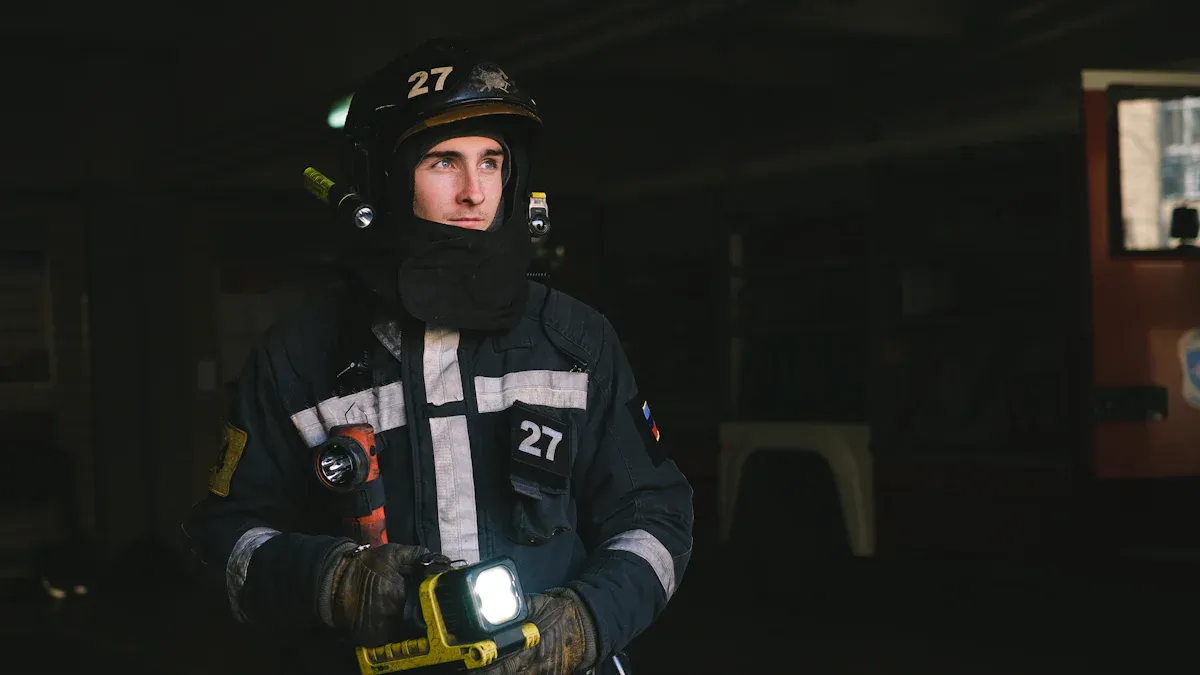How a headlamp can improve your visibility during nighttime activities

Have you ever struggled to see clearly during nighttime activities? A headlamp can be your best ally. It offers reliable lighting in low-light conditions, keeping your hands free for tasks. Whether you're running, camping, or even spelunking, a headlamp ensures safety and convenience. Unlike a helius flashlight, it’s always ready to light your way.
Key Takeaways
A headlamp lets you see without holding a flashlight.
It makes you safer by lighting up dark areas to prevent accidents.
Pick a headlamp with good brightness, long battery, and comfort.
The challenges of nighttime visibility
Risks of poor visibility during nighttime activities
Nighttime visibility is a serious concern, especially when you're out and about after dark. Poor visibility can lead to dangerous situations that you might not even think about until it's too late. For instance, walking or running near roads at night increases your risk of pedestrian-vehicle incidents. Construction zones are even more hazardous. Did you know that 1 in 4 struck-by vehicle deaths happen to construction workers? In high-activity areas with heavy machinery, like trucks or cranes, 75% of fatalities are linked to equipment accidents. These numbers highlight the dangers of nighttime driving and the high nighttime accident rate.
Even if you're not in a high-risk environment, low visibility can still cause trouble. You might trip over unseen obstacles, miss important signs, or fail to notice oncoming traffic. Whether you're driving at night, jogging, or working outdoors, the lack of proper lighting can compromise your nighttime safety.
Why traditional light sources like the helius flashlight may fall short
You might think a helius flashlight is enough to tackle low-light conditions, but it often falls short. Many people complain that traditional flashlights aren't bright enough to illuminate their surroundings effectively. Others find the runtime too short, leaving them in the dark when they need light the most. And let's not forget the confusing modes—High, Strobe, Low? Seriously? These issues make flashlights less reliable for nighttime driving or other activities requiring consistent lighting.
Unlike a flashlight, a headlamp provides hands-free lighting, which is a game-changer. You can focus on the task at hand without juggling a light source. Whether you're navigating a trail, working on a project, or ensuring nighttime safety, a headlamp offers the visibility you need without the hassle.
Benefits of using a headlamp for enhanced visibility

Hands-free operation for multitasking
Imagine trying to hold a flashlight while tying your shoelaces or setting up a tent in the dark. It’s frustrating, right? A headlamp solves this problem by freeing up your hands. You can focus on your tasks without juggling a light source. Whether you’re repairing a car, climbing a tree, or cooking during a camping trip, a headlamp makes multitasking a breeze. Plus, it directs light exactly where you’re looking, ensuring you don’t miss a thing. Unlike traditional flashlights, headlamps are lightweight and reduce arm fatigue, even during prolonged use.
Improved safety and nighttime visibility
Safety is a top priority during nighttime or low-light conditions. A headlamp enhances visibility, helping you avoid accidents like tripping over obstacles or missing important signs. It’s especially useful in confined spaces or hazardous environments, where proper lighting can prevent serious injuries. Some headlamps even come with anti-static properties and secure battery compartments, making them safe for industrial settings. Whether you’re walking your dog, navigating a trail, or working in a dimly lit area, a headlamp ensures you stay visible and safe.
Versatility for activities like running, camping, and working
Headlamps are incredibly versatile tools for outdoor activities. They’re perfect for running, hiking, or biking, as they provide consistent lighting without restricting movement. Campers love them for navigating away from campfires or setting up tents after dark. They’re also essential for spelunking, night fishing, and even power outages. Need to climb a mountain or repair your car? A headlamp has you covered. Its adaptability makes it a must-have for anyone who enjoys outdoor adventures or needs reliable lighting for work.
Types of headlamps and their features

LED headlamps for enhanced brightness and energy efficiency
If you're looking for a headlamp that combines brightness and energy efficiency, LED models are the way to go. These headlamps produce sharp, bright light that cuts through the dark, making them perfect for improving visibility during nighttime activities. LEDs are incredibly energy-efficient because they convert most of their electricity into light rather than heat. This efficiency means they last much longer than other options, with lifespans ranging from 25,000 to 50,000 hours.
Here’s a quick comparison between LED and halogen headlamps:
Features | Halogen | LED |
|---|---|---|
Brightness | Soft light | Sharp and bright light |
Energy Efficiency | Low | High |
Lifespan | 1,000 – 6,000 hours | 25,000 – 50,000 hours |
Heat Emission | High | Low |
LED headlamps also stay cool to the touch, making them safer to use in low-light conditions. Whether you're running at night or working in a dimly lit area, an LED headlamp can improve headlight brightness and keep you safe.
Halogen headlamps and their pros and cons
Halogen headlamps are a more traditional option. They’re affordable and provide good illumination, making them a popular choice for basic needs. However, they come with some drawbacks. Halogen bulbs generate a lot of heat, which wastes energy and can pose safety risks. They also have a shorter lifespan, typically lasting between 1,000 and 6,000 hours.
Here’s a breakdown of their advantages and disadvantages:
Type | Advantages | Disadvantages |
|---|---|---|
Halogen | 1. Low cost 2. Mature technology | 1. Short lifespan 2. High heat generation |
LED | 1. Long life 2. Energy-efficient | 1. Higher cost 2. Requires extra components |
If you're considering a headlight upgrade, halogen headlamps might work for short-term use, but LEDs offer better long-term value.
Specialty modes like red light, strobe, and adjustable brightness
Modern headlamps often come with multiple light modes to suit different needs. Features like adjustable brightness let you control the intensity of the light, which is handy for preserving battery life or adapting to various environments. For example, a dimmer setting works well in close quarters, while a brighter mode improves headlight brightness for outdoor activities.
Some headlamps also include red light and strobe modes. Red light is great for preserving your night vision, especially during stargazing or map reading. Strobe mode, on the other hand, can be a lifesaver in emergencies, helping you signal for help or alert others to your presence. These specialty modes make headlamps incredibly versatile tools for nighttime adventures.
How to choose the right headlamp
Key factors: Brightness, battery life, and comfort
When you're choosing the right headlamp, a few key factors can make all the difference. First, think about brightness. Measured in lumens, brightness determines how well you can see in low-light conditions. For most tasks, 200-300 lumens work perfectly. If you need to see farther, like during a night hike, consider a headlamp with a beam distance of 10-30 meters.
Battery life is another critical factor. A headlamp with at least 10 hours of runtime is great for home use, while 20+ hours is ideal for outdoor adventures. Rechargeable batteries save money over time, but replaceable ones are handy for extended trips. Lastly, comfort matters. Look for a lightweight headlamp (2-4 ounces) with an adjustable strap to ensure it stays secure without causing discomfort.
Activity-specific needs, such as waterproofing or durability
Your activities will influence your choice. If you’re running in the rain or camping near water, a waterproof headlamp is essential. Look for models with an IPX4 rating or higher to ensure they can handle wet conditions. Durability is equally important. A sturdy headlamp can withstand rough handling, making it reliable for hiking, climbing, or emergencies. Weather-resistant designs also protect against dust and debris, ensuring consistent performance in challenging environments.
Balancing budget and performance for the best value
Finding the right balance between budget and performance is key. Headlamps come in a wide price range, so start by identifying the features you need. Affordable options often meet basic requirements, but higher-priced models offer advanced features like specialty modes and longer battery life. Investing a bit more upfront can save you money in the long run by providing better durability and performance. Choose a headlamp that fits your budget while meeting your specific needs.
Headlamps are essential for nighttime visibility and safety. They offer features tailored to your needs, like:
High-beam lights that illuminate objects better than low-beams.
Red light mode to preserve night vision.
SOS functions for emergencies.
Feature | Description |
|---|---|
Dimmable Light | Adjusts brightness to save battery life or suit different environments. |
Lock Function | Prevents accidental activation during storage or transport. |
Choose wisely, and you’ll enjoy nighttime activities with confidence!
FAQ
How do I know how bright my headlamp should be?
Brightness depends on your activity. For casual use, 200-300 lumens work well. For hiking or running, aim for 300+ lumens for better visibility.
Can I use a headlamp in the rain?
Yes! Look for a waterproof headlamp with an IPX4 rating or higher. It’ll handle rain and splashes without any issues.
What’s the best way to maintain my headlamp?
Keep it clean and dry. Remove batteries when not in use to prevent corrosion. Recharge or replace batteries regularly for optimal performance.
💡 Tip: Always check your headlamp’s user manual for specific care instructions!
See Also
Advantages of Utilizing a Red Light Headlamp
Night Fishing Made Easy with a Headlamp
Comprehensive Guide to Buying the Perfect Headlamp
